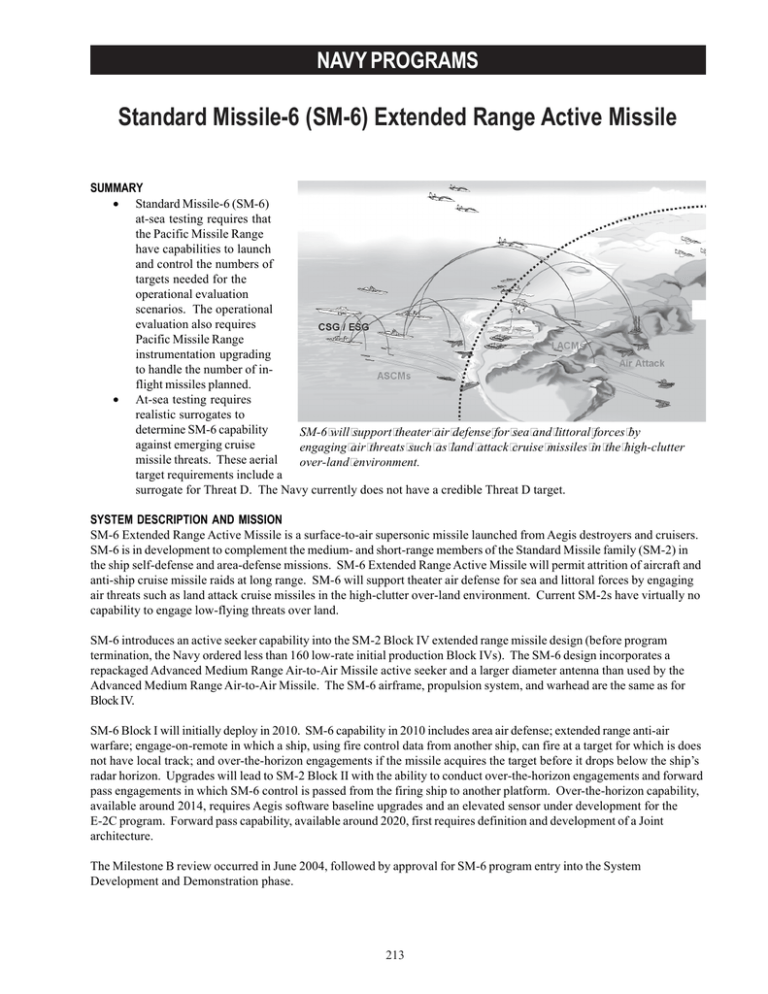Standard Missile-6 (SM-6) Extended Range Active Missile NAVY PROGRAMS
advertisement

NAVY PROGRAMS Standard Missile-6 (SM-6) Extended Range Active Missile SUMMARY • Standard Missile-6 (SM-6) at-sea testing requires that the Pacific Missile Range have capabilities to launch and control the numbers of targets needed for the operational evaluation scenarios. The operational evaluation also requires Pacific Missile Range instrumentation upgrading to handle the number of inflight missiles planned. • At-sea testing requires realistic surrogates to determine SM-6 capability SM-6 will support theater air defense for sea and littoral forces by against emerging cruise engaging air threats such as land attack cruise missiles in the high-clutter missile threats. These aerial over-land environment. target requirements include a surrogate for Threat D. The Navy currently does not have a credible Threat D target. SYSTEM DESCRIPTION AND MISSION SM-6 Extended Range Active Missile is a surface-to-air supersonic missile launched from Aegis destroyers and cruisers. SM-6 is in development to complement the medium- and short-range members of the Standard Missile family (SM-2) in the ship self-defense and area-defense missions. SM-6 Extended Range Active Missile will permit attrition of aircraft and anti-ship cruise missile raids at long range. SM-6 will support theater air defense for sea and littoral forces by engaging air threats such as land attack cruise missiles in the high-clutter over-land environment. Current SM-2s have virtually no capability to engage low-flying threats over land. SM-6 introduces an active seeker capability into the SM-2 Block IV extended range missile design (before program termination, the Navy ordered less than 160 low-rate initial production Block IVs). The SM-6 design incorporates a repackaged Advanced Medium Range Air-to-Air Missile active seeker and a larger diameter antenna than used by the Advanced Medium Range Air-to-Air Missile. The SM-6 airframe, propulsion system, and warhead are the same as for Block IV. SM-6 Block I will initially deploy in 2010. SM-6 capability in 2010 includes area air defense; extended range anti-air warfare; engage-on-remote in which a ship, using fire control data from another ship, can fire at a target for which is does not have local track; and over-the-horizon engagements if the missile acquires the target before it drops below the ship’s radar horizon. Upgrades will lead to SM-2 Block II with the ability to conduct over-the-horizon engagements and forward pass engagements in which SM-6 control is passed from the firing ship to another platform. Over-the-horizon capability, available around 2014, requires Aegis software baseline upgrades and an elevated sensor under development for the E-2C program. Forward pass capability, available around 2020, first requires definition and development of a Joint architecture. The Milestone B review occurred in June 2004, followed by approval for SM-6 program entry into the System Development and Demonstration phase. 213 NAVY PROGRAMS TEST AND EVALUATION ACTIVITY DOT&E approved the SM-6 Test and Evaluation Master Plan (TEMP) in June 2004. The TEMP includes a scenario matrix for operational evaluation agreed upon by the program office, the Navy’s Operational Test and Evaluation Force, and DOT&E. This matrix includes firings against supersonic and subsonic drones representing cruise missile threats, manned and unmanned aircraft surrogates, and will test weapon system interoperability. The TEMP fully integrates live fire test and evaluation with developmental and operational testing. TEST AND EVALUATION ASSESSMENT Planned test and evaluation include both land-based testing at the White Sands Missile Range in FY07-FY08, and seabased testing at the Pacific Missile Range, Hawaii, in FY10. One of DOT&E’s key concerns for operational evaluation is the need to upgrade the range facilities and instrumentation to accommodate the numbers of targets and missiles needed to stage the operational evaluation scenarios. The program office intends to form a Range Upgrade Working Group to ensure that these upgrades take place. Another key concern is the capability to evaluate the effectiveness of SM-6 against Threat D. The Acquisition Decision Memorandum from the Milestone B review identified the requirement to form a Threat D Target Working Group to explore target availability and target options. 214






